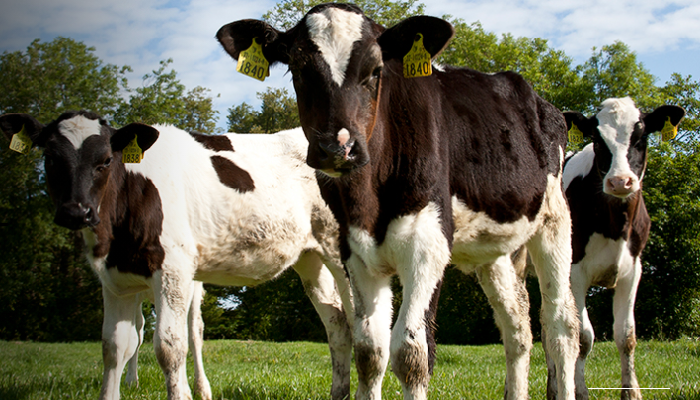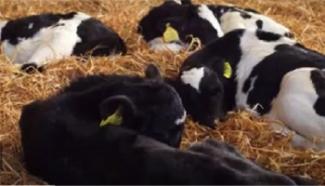Weanling Health and Nutrition

Weanling health and nutrition (PDF)
The primary aim of the winter housing period on calf to beef farms is to ensure weanlings are primed to perform at grass next spring. To achieve this, an average daily gain (ADG) of 0.6kg is required and, for this to occur, health and nutrition must b;e prioritised.
Managing herd health
- Housing provides an opportunity to control both internal and external parasites in cattle.
- Stomach worms, lungworm, liver fluke and rumen fluke can only be picked up at grass; if cattle are treated while housed, they will not be re-infected prior to turnout.
- Alongside a vaccination programme, parasitic treatments at housing or over the winter help avoid negative impacts such as disease, poor growth or sub-standard performance.
- Lice and mange outbreaks are observed most during the housing period and it’s an opportune time to treat such infestations.
- An animal health protocol is recommended to reduce the possibility of disease onset. RSV, PI3, Mannheimia (Pasteurella) haemolytica and IBR are common causes of respiratory diseases in Ireland.
Dosing Strategy
- When dosing, know what actives/classes were previously used to help avoid resistance and what stages of the parasite they control.
- Dose only when needed; use faecal egg count results or animal performance to verify your decision.
- Treatment may be required on farms with a history of liver fluke or where faecal egg counts have confirmed its presence; be aware that a lot of products will only control adult liver fluke.
- Understand the control options for the various stages (early immature, immature, adult) of liver fluke; failing to control immature fluke at housing may lead to the development of mature fluke later in the winter and further treatment may be required.
- Use the recommended rates; don’t under dose animals and administer the product in the correct way.
- If unsure, seek veterinary advice on the product/class best suited to your herd and the treatment methods available.
Table 1: Treatment Options (Actives) and Effects of the Main Parasites Affecting Cattle at Housing
| Parasite | Effect | Treatment (Actives) | |
|---|---|---|---|
| Stomach Worms | Poor performance and reduced ADG |
|
|
| Associated with appetite suppression | |||
| Heavily infected cattle may experience scouring, a lack of thrive and anaemia | |||
| Lungworm | Hoose |
|
|
| Increased risk of pneumonia | |||
| Parasitic bronchitis in previously naïve cattle | |||
| Liver Fluke | Poor performance and reduce ADG |
|
|
| Poor appetite | |||
| Anaemia | |||
| Chewing Lice and Mange |
Poor coat |
|
|
| Scratching | |||
| Poor growth | |||
| Sucking Lice | Anaemia |
|
|
| Poor growth | |||
| Scratching | |||
*Mature liver fluke (10 weeks) controlled; **Immature and mature liver fluke controlled; ***early immature (2 weeks), immature (6 weeks) and mature (10 weeks) liver fluke controlled.
 Nutrition
Nutrition
- A weanling’s demand for energy, protein, fibre, minerals and other elements must be met to ensure an ADG of 0.6 kg is achieved over the housing period.
- Offering poor-quality diets – lacking in energy or protein – will result in reduced weight gains and the potential stunting of dairy-beef weanlings.
- Silage should be of excellent quality; significant savings can be achieved by producing high dry matter digestibility (DMD) silage.
Balancing Silage Quality
- The ability of silage to provide sufficient energy to dairy-beef weanlings is measured through its ME (metabolisable energy) and DMD contents.
- Silage testing is required to evaluate its feed value and to formulate winter diets for weanlings.
- Visual assessment of silage will not provide accurate details on DMD, ME, protein content, dry matter etc.
- Where silage quality is insufficient, supplementary concentrate feeding will be required to ensure ADG targets are achieved.
- Offering only poor-quality silage diets will have a negative impact on winter liveweight gain and the overall lifetime performance of the dairy-beef stock.
Table 2: Average Daily Gains from Different Silage Qualities and Meal Supplementation Requirements
| Silage Quality (DMD) |
ADG on Silage Alone (kg/day) |
Meal Needed (kg/day) for 0.6kg ADG |
Meal Feeding Cost Over 120 Days (€/head at €280/t ration) |
|---|---|---|---|
| 75 | +0.50 | 0.50 | 17 |
| 70 | +0.35 | 1.50 | 50 |
| 65 | +0.20 | 2.00 | 67 |
| 60 | 0.0 | 3.00 | 100 |
| 55 | -0.20 | 3.50 | 118 |
Feeding a Supplementary Concentrate
- Concentrates should be medium to high in energy (0.90-0.96 UFL).
- 16% crude protein or higher if silages are low in protein.
- Fortified with vitamins and minerals.
- Palatable, fresh smelling and free of dust.
- Front loaded to the first half of the housing period to maximise compensatory growth post turnout.
- Fresh, clean drinking water needs to be available at all times.
Space Requirements
Careful attention should be paid to the size of the shed available, as overcrowding can lead to a significant reduction in animal performance. Don’t overstock sheds and
ensure ventilation is sufficient. The two space requirements that need consideration are floor space and feeding space (Table 3).
Table 3: Floor Space and Feeding Space Requirements
| Floor Space Requirements | ||
|---|---|---|
| Slatted Housing | Straw Bedded Housing | |
| Cattle >275kg | 2 – 2.5 m2/animal | 4.0m2/animal |
| Cattle >275kg | 1.2 – 1.5m2/animal | 2.4 – 3.0m2/animal |
| Feeding Space Requirements | ||
| Ad-lib roughage | 225 – 300 mm/head | |
| Restricted roughage | 400 – 500 mm/head | |
| Concentrate supplementation | 400 – 500 mm/head | |
